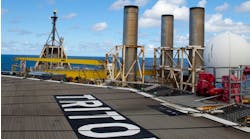View Article as Single page
Long-term thinking
Big oil needs big projects and with the Middle-Eastern NOCs dominating onshore production, deepwater remains one of the few places the IOCs can make major finds. Also, the largest offshore projects are not greatly influenced by today's oil prices. Instead, planners project what prices will be in the decades ahead. Many expect oil prices to again average $100 in the medium-long term. Considering the lead times of large offshore projects, there is less potential to revise near-term development plans. As a result, capex tends to be less subject to short-term hits than onshore spends, such as US onshore drilling.
Yes, there will be significant spending cut-backs as higher-cost, more economically marginal offshore projects are postponed, and exploration spend will also be reduced if E&P companies decide to wait for rig rates to fall further. However, it is likely that deepwater, despite its costs, is one area that will suffer less than others. So we feel confident about the long-term prospects for associated areas such as subsea production and floating production.
Another example of long-term thinking is FLNG – the scale of Shell's investment in its huge Prelude project clearly shows this. Over the next five years we expect to see capital expenditure of $41 billion on such units and a further $21 billion on regasification vessels.
In total, we estimate that some $212 billion was spent on offshore E&P in 2013; and that 2014 spend will have been even higher, when the totals come in. Looking ahead, key spending sectors will be offshore drilling at 31%, subsea at 15%, and engineering/construction at 15%. The other major sector is "life of field" expenditure at 39%.
M&A opportunities
As evidenced with past cycles, the present downturn could be a great buying opportunity. In global E&P the NOCs rule and they will continue to invest; China has been the high spender and India's ONGC now plans a huge $180 billion foreign production acquisition spree. Likewise in oilfield services – acquisition opportunities are likely to present themselves for both strategic and private equity buyers, as was the case in the last downturn. Even without oil demand growth – which is extremely unlikely – vast numbers of new development wells will need drilling worldwide each year to counter natural production decline rates of typically 7-10% per annum for conventional wells and up to 60% for unconventionals such as in the US shale plays.
It's likely that more than 80,000 development wells were drilled onshore in 2014 and some 2,500 offshore. Looking ahead, even greater numbers will be needed as present low oil prices begin to drive growing oil and gas consumption, boosting the demand for oilfield services. Furthermore, we believe that the annual total will need to grow to exceed 100,000 by 2020.
Over the past 30 years, growth in oil demand has been remarkably resilient to oil price changes – following the 2008 financial crises average annual oil prices fell by 37% in 2009, yet oil demand only fell 1% and was growing again in 2010.
Both high and low oil prices present opportunities for well-managed, well-financed companies that have a long-term view – the oil and gas industry is not a short-term game. But the window of M&A opportunity may well be very short before the next cycle begins.
The author
John Westwood is chairman of Douglas-Westwood, the international energy business research and consulting firm he founded in 1990. The firm recently completed its 1,000th project. In addition to oil companies, contractors and financial organizations, Westwood has advised government agencies and presidential offices in six countries.


